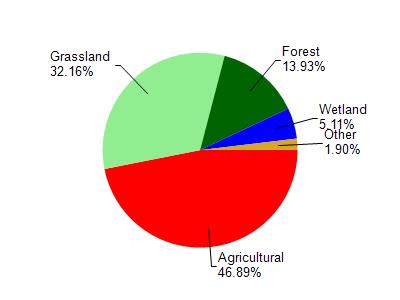Green
Yes
Yes
Yes
Fish and Aquatic Life
Overview
The Center Branch is similar to the North Branch. It is a Class III trout stream in the lower portion with potential to be a Class II stream. The lower one mile is also an ERW. The stream has not been monitored recently.
Date 2002
Author Aquatic Biologist
Historical Description
Bush, D.M., R. Cornelius, D. Engle, and C.L. Brynildson. 1980. Lake and Stream Classification Project. Surface Water Resources of Green County, 2nd Edition. Wisconsin Department of Natural Resources, Madison, Wisconsin.
Flowing southeast from the driftless area, this small stream enters Hefty Creek just above the Little Sugar River West Branch. It flows through cropland and pasture and the lower part experiences considerable bank erosion. The water is generally turbid and much of the upper part has been straightened by ditching. Gravel and rubble are the main bottom types but some sand and silt are present.
The entire stream is classified as Class III brown trout water although there are very few pools and little instream cover in the upper portions. A very limited amount of natural trout reproduction may occur near a spring in Section 10. Forage fish including the rare redside dace are also present. Wildlife values are limited to muskrats and public access consists of two road crossings.
Fish Species: Brown trout, central stoneroller, redside dace, common shiner, southern redbelly dace, creek chub, white sucker, brook stickleback.
Gradient = 30 ft./mi., Base Discharge = 5.6 cu. ft./sec.
Surface Acres = 2.5, Length = 4.2 Mi1es,
Date 1980
Author Surface Water Inventory Of Wisconsin
Condition
Wisconsin has over 84,000 miles of streams, 15,000 lakes and milllions of acres of wetlands. Assessing the condition of this vast amount of water is challenging. The state's water monitoring program uses a media-based, cross-program approach to analyze water condition. An updated monitoring strategy (2015-2020) is now available. Compliance with Clean Water Act fishable, swimmable standards are located in the Executive Summary of Water Condition in 2018. See also the 'monitoring and projects' tab.
Reports
Management Goals
Wisconsin's Water Quality Standards provide qualitative and quantitative goals for waters that are protective of Fishable, Swimmable conditions [Learn more]. Waters that do not meet water quality standards are considered impaired and restoration actions are planned and carried out until the water is once again fishable and swimmable
Management goals can include creation or implementation of a Total Maximum Daily Load analysis, a Nine Key Element Plan, or other restoration work, education and outreach and more. If specific recommendations exist for this water, they will be displayed below online.
Monitoring
Monitoring the condition of a river, stream, or lake includes gathering physical, chemical, biological, and habitat data. Comprehensive studies often gather all these parameters in great detail, while lighter assessment events will involve sampling physical, chemical and biological data such as macroinvertebrates. Aquatic macroinvertebrates and fish communities integrate watershed or catchment condition, providing great insight into overall ecosystem health. Chemical and habitat parameters tell researchers more about human induced problems including contaminated runoff, point source dischargers, or habitat issues that foster or limit the potential of aquatic communities to thrive in a given area. Wisconsin's Water Monitoring Strategy was recenty updated.
Grants and Management Projects
Monitoring Projects
| WBIC | Official Waterbody Name | Station ID | Station Name | Earliest Fieldwork Date | Latest Fieldwork Date | View Station | View Data |
|---|
| 882200 | Center Br Hefty Creek | 10017215 | Hefty Cr.-First Riffle Downstream Of 2nd Bridge Off Hwy N. | 4/18/1980 | 1/1/2015 | Map | Data |
| 882200 | Center Br Hefty Creek | 10010909 | Center Br Hefty Creek - Hefty Creek Center Branch At Hefty Rd | 10/10/2011 | 4/21/2021 | Map | Data |
|

Watershed Characteristics
Center Br Hefty Creek is located in the Little Sugar River watershed which is 133.02 mi². Land use in the watershed is primarily agricultural (46.80%), grassland (32.10%) and a mix of forest (13.90%) and other uses (7.00%). This watershed has 351.74 stream miles, 50.40 lake acres and 3,252.10 wetland acres.
Nonpoint Source Characteristics
This watershed is ranked Not Ranked for runoff impacts on streams, Not Ranked for runoff impacts on lakes and High for runoff impacts on groundwater and therefore has an overall rank of High. This value can be used in ranking the watershed or individual waterbodies for grant funding under state and county programs.However, all waters are affected by diffuse pollutant sources regardless of initial water quality. Applications for specific runoff projects under state or county grant programs may be pursued. For more information, go to surface water program grants.